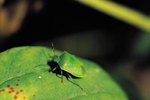
Woodlice go by a great number of common names, some more colloquial or regional than others. These many names include slaters, pill bugs, doodlebugs and roly polies. They all refer to the same creatures – crustaceans of the order Oniscidea, which contains more than 5,000 species. While some variations in appearance, behavior and habitat exist, all woodlice have much the same life cycle.
The Big Picture
They might be commonly referred to as bugs, but woodlice are crustaceans, and so more closely related to lobsters and crabs than they are to insects. The ancestor of modern woodlice was a marine creature, and a few aquatic species do exist, including some that returned to the water, as well as ancient ones that never left. The majority of today’s species might not be aquatic, but their skins are not fully waterproof, meaning they need damp habitats. In dry conditions, they dehydrate.
Key Stages
Woodlice have four main life stages: egg, manca (which has two sub-stages) juvenile (which has several sub-stages) and adult. The egg stage is self-explanatory, although you probably won’t ever see woodlice eggs, as they are carried in their mother's pouch. The eggs hatch into mancae, which look much like adult woodlice but are but much paler, normally white or a very pale yellow, and have fewer legs. They undergo two molts -- they shed their skins -- in the manca stage, one into more independent mancae and the next into juvenile woodlice. The juvenile woodlice are minute versions of the adults. As with many other arthropods, the juvenile woodlice continue molting periodically until they reach their full size a year or more later. In the adult stage, they can breed.
Roly Poly Childrearing
Like marsupial mammals, female woodlice carry their young in pouches. Once the eggs are fertilized, the female carries them around in a large brood pouch on her belly until they hatch, often weeks later. The young are in the manca stage, and they remain in the pouch for about one more day before undergoing their first molt and emerge shortly afterwards in a more independent form of manca. On the next molt, they darken.
What's for Dinner?
Juvenile and adult woodlice eat the same type of things. Like the preferred habitat, the woodlouse diet is also pretty damp, consisting nearly entirely of decaying plant material, often rotten wood. Despite a name reminiscent of woodworm and other nuisances, woodlice are not actually pests; they almost never consume living plants and are physically incapable of consuming solid wood. If you see large numbers of woodlice inside, you probably do have a problem but it’s not the woodlice -- their presence indicates dampness.
References
Photo Credits
-
Jupiterimages/Photos.com/Getty Images
Writer Bio
Judith Willson has been writing since 2009, specializing in environmental and scientific topics. She has written content for school websites and worked for a Glasgow newspaper. Willson has a Master of Arts in English from the University of Aberdeen, Scotland.



